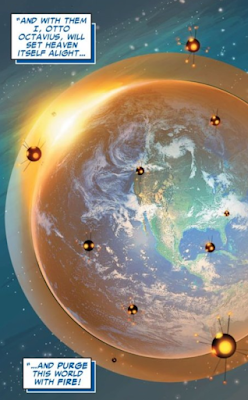DC Universe: Rebirth #1
by Geoff Johns, Ethan Van Sciver, Gary Frank, Ivan Reis, Phil Jimenez
Geoff Johns became the chief creative officer at DC for a number at reasons. But if you just look at his bibliography, you can see why. He wrote a stable of Green Lantern and The Flash stories, reviving hidden meaning in the lore established in the past, and established a framework of stories in what were some of DC Comics' otherwise-mundane history. For example, in
Green Lantern: Rebirth, he rewrote Parallax -- at the time, the evil alter-ego of Hal Jordan -- into a yellow energy creature that embodied fear, that had possessed Hal. The original story (
Zero Hour: Crisis in Time) was still true; readers hadn't wasted their time with that miniseries. It was just a wrinkle to the story now, that allowed a whole new story to tell.
Johns does the same thing here. It seemed that, at the time of the New 52 reboot, superheroes were miraculously de-aged. It was the impetus to tell new stories with heroes who were otherwise old, as much as 3/4 of a century old! People didn't know which stories were true anymore, and which stories weren't. The general consensus was that they were still true, but that brought a furrow to readers' brows, when Batgirl (Barbara Gordon) was never crippled by the Joker in
The Killing Joke, but continued to be Batgirl. Or when Wally West was actually black, instead of caucasian as in the pre-New 52. The New 52 just wasn't reconcilable with a number of past stories.
DC seems ready to address these contradictions now. The "New 52" Wally is actually
another nephew of Barry's with the same name, and the "legacy" Wally, the one that eventually became the Flash when Barry died, is trapped in the Speed Force! This 80-page giant takes us on a five-part tour through the DC Universe as Wally tries to escape the Speed Force, and warn people that The New 52 didn't happen because of the events in
Flashpoint. They happened because of someone's interference.
As if to say "Oops" DC (re-)introduces to us the vestiges of stories it had seemed to ignore. Ryan Choi, who had replaced Ryan Palmer as the Atom, and Jaime Reyes, who replaced Ted Kord as the Blue Beetle. Green Arrow and Black Canary, who were married pre-New 52, now barely know each other.
Wally jumps from person to person, each one failing to remember him, each one failing to save him from the Speed Force. Until Barry does. In a flash, Barry remembers the adventures they had together as Flash and Kid Flash, when Wally joined the Teen Titans, and those other stories. Not much else happens there. We're left to wonder exactly who tampered with the DC Universe timeline, as we're shown a clock reconstructed on Mars, presumably Dr. Manhattan of
Watchmen fame.
DC Universe: Rebirth rebooted the full DC lineup, again, back to #1. Superman got a new #1, as did Batman, Wonder Woman, and so on. You name it, they rebooted it. But, it seems that it's still the same characters as we left them, from the New 52 numbering. They're just carrying on with new #1s, but some people (The Flash) are aware of their pre-new 52 lives. DC continues to rejigger their continuity, but did it really need any rejiggering? Do we need another universes-spanning event that rewrites past events? How many times are we going to (re-)hear our heroes' origins? Why do new stories need to re-tell old stories to work?
One could imagine this being a gateway comic for anyone, a great jumping-on point for someone new to comics. . . it certainly isn't. There's nods and flashbacks to a host of other DC stories, the visual vocabulary evoking stories like Barry's cry for help in
Crisis on Infinite Earths, the 9-page grid of
Watchmen, and the first issue cover to
Flashpoint, to name a few. If you haven't read up on these, you're already three laps behind the readers who have.
For those obsessed with continuity, and with fitting in comic books year-by-year, this is the comic for you. In other words, for the super-fan, this is your comic. For everyone else, well, at least there are new #1's so you can jump on whenever you like. For me, I just want good stories.
Follow chezkevin on
rss |
twitter





















































